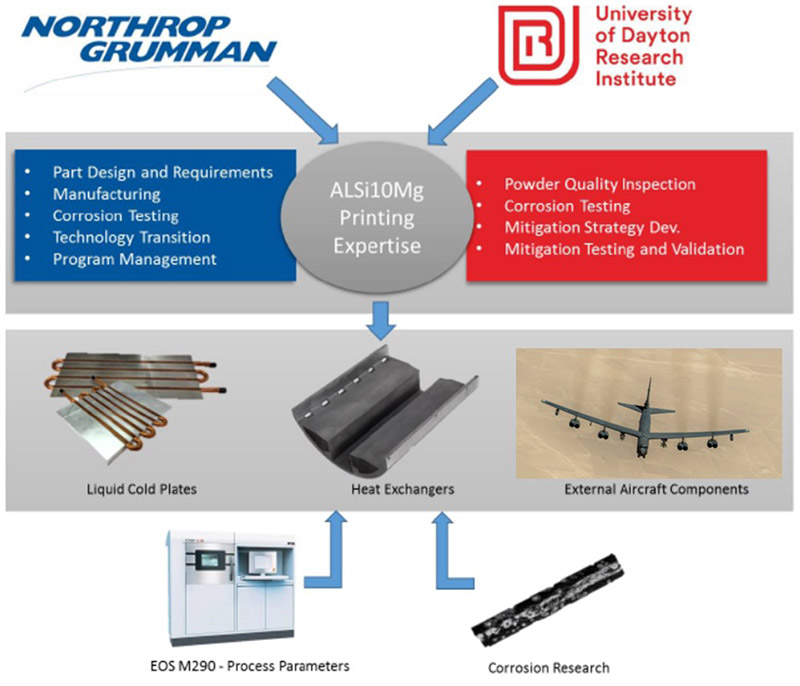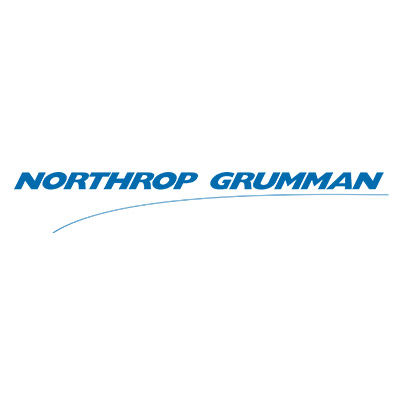


Liquid cold plates, heat exchangers, and external aircraft components are of interest for this corrosion investigation by the team composed of Northrop Grumman Systems Corporation (NGSC) and the University of Dayton Research Institute (UDRI).
Problem
Defense systems are becoming increasingly electronic with embedded computing systems which require complex, lightweight, structurally integrated cooling components. Laser powder bed fusion (LPBF) has unique advantages for manufacturing structurally integrated parts in such applications. Current LPBF alloys like AlSi10Mg, however, exhibit corrosion behavior unique to additive manufacturing (AM), which is dependent on manufacturing artifacts such as roughness, surface porosity, the presence of protective films, and process melt pool solidification dynamics. This unique corrosion behavior is not yet well understood and creates a roadblock to the Department of Defense (DoD) adoption of LPBF parts for mission-critical defense systems in potentially corrosive environments.
Objective
The objective of the study was to advance the understanding of corrosion mechanisms of AlSi10Mg parts produced by LPBF and to validate mitigation strategies to facilitate adoption in DoD hardware. Specifically, the team sought to research corrosion mechanisms of LPBF AlSi10Mg; correlate results from screening testing to manufacturing key process input variables (KPIVs) and develop manufacturing best practices and corrosion mitigation strategies; validate mitigation strategies against the current manufacturing best practices; and create a manufacturing process guideline, specific to corrosion mitigation of LPBF AlSi10Mg, for America Makes and DoD supply chain partners.
Technical Approach
The project team was led by Northrup Grumman (NG) and included the University of Dayton Research Institute (UDRI). The technical approach was to define requirements based on DoD part families for AM at NG and UDRI. The team identified and tested corrosion mechanisms of concern to enhance understanding of AlSi10Mg corrosion as a function of heat treatment, surface roughness, and finish. Finish refers to chromate conversion coatings and/or primers. NG conducted salt fog, humidity testing, and beachfront testing to understand localized corrosion susceptibility in these environments. UDRI conducted microbial-induced corrosion (MIC) and stress corrosion cracking (SCC) testing to understand these susceptibilities in JP-8 and chlorides, respectively. Corrosion mitigation strategies based on corrosion screening results were developed and tested. Full component testing and analysis at NG and UDRI were performed. UDRI focused on internal environments, whereas NG focused on external environments. Finally, manufacturing process guidelines were created for corrosion prevention practices for AM AlSi10Mg through a joint effort between the partners.
Accomplishments
This project generated corrosion prevention guidance for designers of LPBF AlSi10Mg hardware, particularly for heat exchanger applications, by evaluating a broad range of corrosion mechanisms and environments in screening testing and confirming the effectiveness of mitigation steps with coupon- and component-level testing. The part families identified at the beginning of the program were heat exchangers and external aircraft components. Key input and output variables were identified for incorporation in screening test matrices, which covered a wide range of tests/environments, including SCC, MIC, polarization testing, and exposures to beachfront atmosphere, salt fog, coolant immersion, and alternate seawater immersion.
The screening testing showed that AlSi10Mg largely performed similarly to wrought and cast aluminum controls, but some considerations unique to AM were discovered. In particular, conversion coating of as-printed surfaces showed it could be effective in reducing pit density in marine and salt fog exposures but was not as effective at reducing pit depth. Also, pitting showed to reduce elongation in SCC testing, which did not show AlSi10Mg was susceptible to SCC, but enforces the need for protective coatings, especially in high-stress areas.
Finally, although not unique to AM applications, the importance of coolant packages was demonstrated in MIC, coolant immersion, and polarization testing—all aluminum samples (including AlSi10Mg) performed acceptably, but some packages provided more stable protection than others. A representative heat exchanger geometry was designed, modeled, built, and tested in a corrosion-relevant environment, based on the requirements identified at the beginning of the project. Full component test results showed that by employing the corrosion prevention mitigation strategies captured in the guidelines generated from this project, AlSi10Mg produced by LPBF met the performance requirements of a heat exchanger application in production-relevant internal and external environments, largely with little sign of corrosion.
Project Participants
Project Principal

Other Project Participants
- University of Dayton Research Institute
Public Participants
- U.S. Department of Defense
